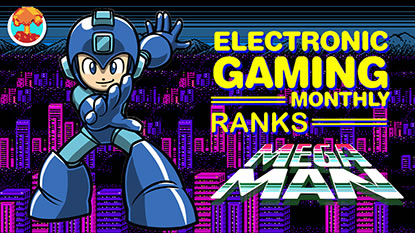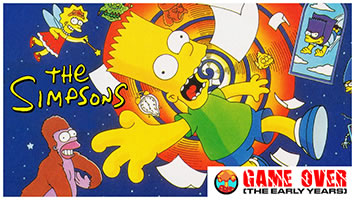- CLASSIC MAGAZINES
- REVIEW CREW
A show recapping what critics thought back
when classic games first came out! - NEXT GENERATION'S BEST & WORST
From the worst 1-star reviews to the best
5-stars can offer, this is Next Generation! - NINTENDO POWER (ARCHIVE)
Experience a variety of shows looking at the
often baffling history of Nintendo Power! - MAGAZINE RETROSPECTIVE
We're looking at the absolutely true history of
some of the most iconic game magazines ever! - SUPER PLAY'S TOP 600
The longest and most ambitious Super NES
countdown on the internet! - THEY SAID WHAT?
Debunking predictions and gossip found
in classic video game magazines! - NEXT GENERATION UNCOVERED
Cyril is back in this spin-off series, featuring the
cover critic review the art of Next Generation! - HARDCORE GAMER MAGAZING (PDF ISSUES)
Download all 36 issues of Hardcore Gamer
Magazine and relive the fun in PDF form!
- REVIEW CREW
- ELECTRONIC GAMING MONTHLY
- ELECTRONIC GAMING MONTHLY RANKS
From Mario to Sonic to Street Fighter, EGM
ranks classic game franchises and consoles! - ELECTRONIC GAMING MONTHLY BEST & WORST
Counting down EGM’s best and worst reviews
going year by year, from 1989 – 2009! - ELECTRONIC GAMING BEST & WORST AWARDS
11-part video series chronicling the ups and
downs of EGM’s Best & Worst Awards!
- ELECTRONIC GAMING MONTHLY RANKS
- GAME HISTORY
- GAME OVER: STORY BREAKDOWNS
Long-running series breaking down game
stories and analyzing their endings! - A BRIEF HISTORY OF GAMING w/ [NAME HERE]
Real history presented in a fun and pithy
format from a variety of game historians! - THE BLACK SHEEP
A series looking back at the black sheep
entries in popular game franchises! - INSTANT EXPERT
Everything you could possibly want to know
about a wide variety of gaming topics! - FREEZE FRAME
When something familiar happens in the games
industry, we're there to take a picture! - I'VE GOT YOUR NUMBER
Learn real video game history through a series
of number-themed episodes, starting at zero! - GREAT MOMENTS IN BAD ACTING
A joyous celebration of some of gaming's
absolute worst voice acting!
- GAME OVER: STORY BREAKDOWNS
- POPULAR SHOWS
- DG NEWS w/ LORNE RISELEY
Newsman Lorne Riseley hosts a regular
series looking at the hottest gaming news! - REVIEW REWIND
Cyril replays a game he reviewed 10+ years
ago to see if he got it right or wrong! - ON-RUNNING FEUDS
Defunct Games' longest-running show, with
editorials, observations and other fun oddities! - DEFUNCT GAMES QUIZ (ARCHIVE)
From online quizzes to game shows, we're
putting your video game knowledge to the test!- QUIZ: ONLINE PASS
Take a weekly quiz to see how well you know
the news and current gaming events! - QUIZ: KNOW THE GAME
One-on-one quiz show where contestants
find out if they actually know classic games! - QUIZ: THE LEADERBOARD
Can you guess the game based on the classic
review? Find out with The Leaderboard!
- QUIZ: ONLINE PASS
- DEFUNCT GAMES VS.
Cyril and the Defunct Games staff isn't afraid
to choose their favorite games and more! - CYRIL READS WORLDS OF POWER
Defunct Games recreates classic game
novelizations through the audio book format!
- DG NEWS w/ LORNE RISELEY
- COMEDY
- GAME EXPECTANCY
How long will your favorite hero live? We crunch
the numbers in this series about dying! - VIDEO GAME ADVICE
Famous game characters answer real personal
advice questions with a humorous slant! - FAKE GAMES: GUERILLA SCRAPBOOK
A long-running series about fake games and
the people who love them (covers included)! - WORST GAME EVER
A contest that attempts to create the worst
video game ever made, complete with covers! - LEVEL 1 STORIES
Literature based on the first stages of some
of your favorite classic video games! - THE COVER CRITIC
One of Defunct Games' earliest shows, Cover
Critic digs up some of the worst box art ever! - COMMERCIAL BREAK
Take a trip through some of the best and
worst video game advertisements of all time! - COMIC BOOK MODS
You've never seen comics like this before.
A curious mix of rewritten video game comics!
- GAME EXPECTANCY
- SERIES ARCHIVE
- NINTENDO SWITCH ONLINE ARCHIVE
A regularly-updated list of every Nintendo
Switch Online release, plus links to review! - PLAYSTATION PLUS CLASSIC ARCHIVE
A comprehensive list of every PlayStation
Plus classic release, including links! - RETRO-BIT PUBLISHING ARCHIVE
A regularly-updated list of every Retro-Bit
game released! - REVIEW MARATHONS w/ ADAM WALLACE
Join critic Adam Wallace as he takes us on a
classic review marathon with different themes!- DEFUNCT GAMES GOLF CLUB
Adam Wallace takes to the links to slice his way
through 72 classic golf game reviews! - 007 IN PIXELS
Adam Wallace takes on the world's greatest spy
as he reviews 15 weeks of James Bond games! - A SALUTE TO VAMPIRES
Adam Wallace is sinking his teeth into a series
covering Castlevania, BloodRayne and more! - CAPCOM'S CURSE
Adam Wallace is celebrating 13 days of Halloween
with a line-up of Capcom's scariest games! - THE FALL OF SUPERMAN
Adam Wallace is a man of steel for playing
some of the absolute worst Superman games! - THE 31 GAMES OF HALLOWEEN
Adam Wallace spends every day of October afraid
as he reviews some of the scariest games ever! - 12 WEEKS OF STAR TREK
Adam Wallace boldly goes where no critic has
gone before in this Star Trek marathon!
- DEFUNCT GAMES GOLF CLUB
- DAYS OF CHRISTMAS (ARCHIVE)
Annual holiday series with themed-episodes
that date all the way back to 2001!- 2015: 30 Ridiculous Retro Rumors
- 2014: 29 Magazines of Christmas
- 2013: 29 Questionable Power-Ups of Christmas
- 2012: 34 Theme Songs of Christmas
- 2011: 32 Game Endings of Christmas
- 2010: 31 Bonus Levels of Christmas
- 2009: 30 Genres of Christmas
- 2008: 29 Controls of Christmas
- 2007: 34 Cliches of Christmas
- 2006: 33 Consoles of Christmas
- 2005: 32 Articles of Christmas
- 2004: 31 Websites of Christmas
- 2003: 29 Issues of Christmas
- 2002: 28 Years of Christmas
- 2001: 33 Days of Christmas
- NINTENDO SWITCH ONLINE ARCHIVE
- REVIEW ARCHIVE
- FULL ARCHIVE
You Missed Your Opportunity, Midway
Hard Drivin'
[ Could Have Been: Virtua Racing ]
Brief Synopsis:
Hard Drivin' was a slow moving driving-simulator/racing game. It's best known for its framey polygon movement and complete lack of understandable goals. Is it wanting me to race against these other players or just hit the checkpoints? Why when the game says I'm going 60 miles per hour it actually feels like I'm standing still? Why does this blasted arcade cabinet hate me so much? These were some of the thoughts people
[ Could Have Been: Virtua Racing ]
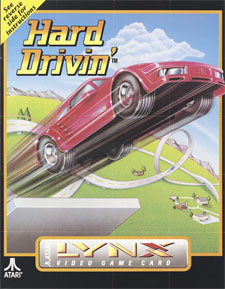
A horrible, choppy arcade game isn't made any better when you lower the res and port it to a handheld game system!
Missed Opportunity For the most part, each of the missed opportunities has had something to do with the genre. We talked about Smash TV and Road Blasters because they reminded us of popular games that came later. But Hard Drivin' (and its 1990 sequel, Race Drivin') is on the list because of the technology it attempted to employ. In a world full of sprite-based racing games, Atari decided that the way to go was with revolutionary 3D polygons. Albeit simple, these polygons gave the game a unique look and feel, something that Atari quickly learned was a double edge sword.
It's not that Atari was the first game company to use these 3D polygons, they certainly weren't. However, Atari definitely went further than anybody had before. What's more, Atari proved that they had the right idea; they just didn't have the expertise to pull it off ... yet. But there was still plenty of time. Had Atari stuck with this idea (as opposed to spending so much time developing failed home consoles) they may have been able to beat Sega to the punch. Sure Hard Drivin' and Race Drivin' aren't much fun, but the seeds of greatness were in there somewhere. All it would have taken was another year and some better programmers and you would have had the Virtua Racing killer. But Atari, you missed your opportunity.
720 Degrees
[ Could Have Been: Tony Hawk's Pro Skater ]
Brief Synopsis:
720 Degrees was one of the earliest skateboarding games, combining huge ticks and impressive level designs. Shown from an overhead perspective, 720 Degrees emphasized racking up huge points by pushing your tricks as far as they can go. Unfortunately due to the game's limited controls this title
[ Could Have Been: Tony Hawk's Pro Skater ]
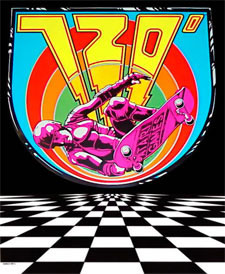
I'm begging you skate fans, don't go back and try to play through 720 Degrees!
Missed Opportunity Maybe we should give Atari credit for trying. Skateboarding isn't exactly the easiest "sport" to recreate, especially when we're talking about in an arcade. Atari didn't have the technology to pull off what Tony Hawk's Pro Skater did 13 years later, so it shouldn't surprise anybody that 720 Degrees is a total mess. But just because your first attempt didn't work, that's no reason you should give up on the idea of making an arcade-style skateboarding game. I hear they will eventually be really popular.
There were 13 long years between 720 Degrees and Tony Hawk's impressive run, there was plenty of time to refine the core gameplay and really impress the judges. But no, Atari just gave up and decided that skateboarding wasn't worth it. And when Midway picked up the rights to the game, they too decided that skateboarding couldn't be done in a video game. Sadly they were both wrong, because Activision proved that with the right name and the right gameplay you can have one of the biggest game franchises of all time. Atari could have done this. In those 13 years they would have gotten the formula right eventually. They just didn't trust themselves to do it. They didn't even try. It's hard to fathom how different Atari's financial outlook would be had they been the company with a top selling skateboarding game every year of this last decade.
Road Blasters
[ Could Have Been: Full Auto ]
Brief Synopsis:
This single player arcade game was a combination of OutRun and Spy Hunter. It featured a futuristic setting where you drove as fast as you could while shooting other vehicles out of your way. The main draw of this arcade game was the fact that you could earn power-ups that made it easier to blow up enemies in front of you and, in one case, actually drive right
[ Could Have Been: Full Auto ]
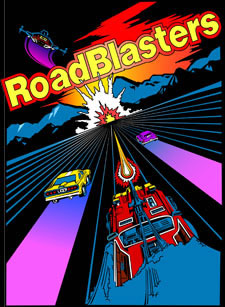
As cool as this poster is, the real Road Blasters was even better!
Missed Opportunity Road Blasters was a personal favorite when I was a kid. I especially loved being able to use a weapon so powerful that it literally allowed you to drive through the other cars. Who wouldn't want something like that in real life? And even if that's not very realistic, I would still settle for a gun turret mounted on the top of my car for those lengthy commutes. All joking aside, there's no denying that Road Blasters (which is no relation to Math Blaster) is full of great ideas. Its only sin is that it came out far too early to capitalize on the combat racing sub-genre.
In a lot of ways Road Blasters was the predecessor to games like Twisted Metal and Vigilante 8, however in tone and gameplay its has more
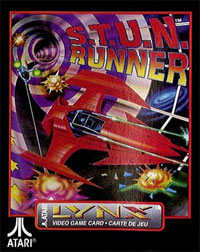
S.T.U.N. Runner is a game that holds up remarkably well, even the Lynx port is worth playing through!
On a brief side note, Road Blasters wasn't the company's only attempt. Arcade (or Lynx) fans will remember S.T.U.N. Runner, a futuristic hovercraft racing game. This 1989 game is essentially the blueprint for the wipEout series. This game, along with the 1987 release of Road Blasters, proved that Atari was on the right path and would have eventually hit pay dirt with these combat-heavy arcade racers. But Atari never followed up on either S.T.U.N. Runner or Road Blasters, which ultimately cost them a lot of money.
San Francisco Rush
[ Could Have Been: Burnout ]
Brief Synopsis:
San Francisco Rush was the biggest arcade racer of the time, a competitive action game full of paint-swapping, big jumps and
[ Could Have Been: Burnout ]
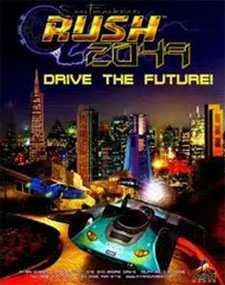
Drive the future? But we can do that in the present! We're in the future, aren't there more important things to do than drive?
Missed Opportunity Of all the games listed in this article, San Francisco Rush is arguably the most popular. Sure Marble Madness had a following and everybody loves Smash TV, but it's hard to compete
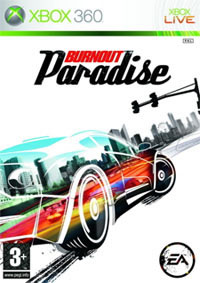
It didn't hurt that Criterion Games continued to support Burnout Paradise with free downloadable content!
Things got even more explosive with the release of San Francisco Rush 2049. This futuristic racing game gave us new moves and more shortcuts, along with more in-your-face action. These games (along with the faux-expansion pack
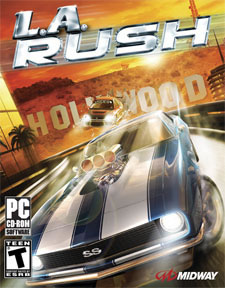
Between Midnight Club: Los Angeles, L.A. Rush, San Andreas and True Crime, I feel like I'm seen every inch of Los Angeles!
The San Francisco Rush series predated Burnout by a full five years, plenty of times to solidify their place as THE arcade-style racing game of choice. But that's not what happened. Instead the license holders decided to wait six long years before releasing 2005's poorly received L.A. Rush. In that time Burnout had after-touched their way to victory. To add insult to injury, both L.A. Rush and the curiously titled PSP game, Rush, are set in an open world Los Angeles. A mere three years later Criterion Games unleashed Burnout Paradise and effectively killed the Rush series.
With games like 720 Degrees and Hard Drivin' it's easy to speculate that with a little more time and better technology they would have revolutionized the industry. Who knows what the future holds? It's just as likely that they would have continued to release sub-standard racing games and what they really needed was that special something that Activision and Sega brought to their projects. San Francisco Rush is different; it's not a matter of speculating. There's no question that when it came to arcade games, San Francisco Rush was at the top of their game in the late 1990s. But their inability to release a new game and the terribleness of L.A. Rush doomed the franchise. Midway is to blame here. There's no question that this series could still be as big as Burnout, but both Atari and Midway missed their opportunity. They just let it go. And that is why they are in such dire straits.
HOME |
CONTACT |
NOW HIRING |
WHAT IS DEFUNCT GAMES? |
NINTENDO SWITCH ONLINE |
RETRO-BIT PUBLISHING
Retro-Bit |
Switch Planet |
The Halcyon Show |
Same Name, Different Game |
Dragnix |
Press the Buttons
Game Zone Online | Hardcore Gamer | The Dreamcast Junkyard | Video Game Blogger
Dr Strife | Games For Lunch | Mondo Cool Cast | Boxed Pixels | Sega CD Universe | Gaming Trend
Game Zone Online | Hardcore Gamer | The Dreamcast Junkyard | Video Game Blogger
Dr Strife | Games For Lunch | Mondo Cool Cast | Boxed Pixels | Sega CD Universe | Gaming Trend
Copyright © 2001-2024 Defunct Games
All rights reserved. All trademarks are properties of their respective owners.
All rights reserved. All trademarks are properties of their respective owners.













